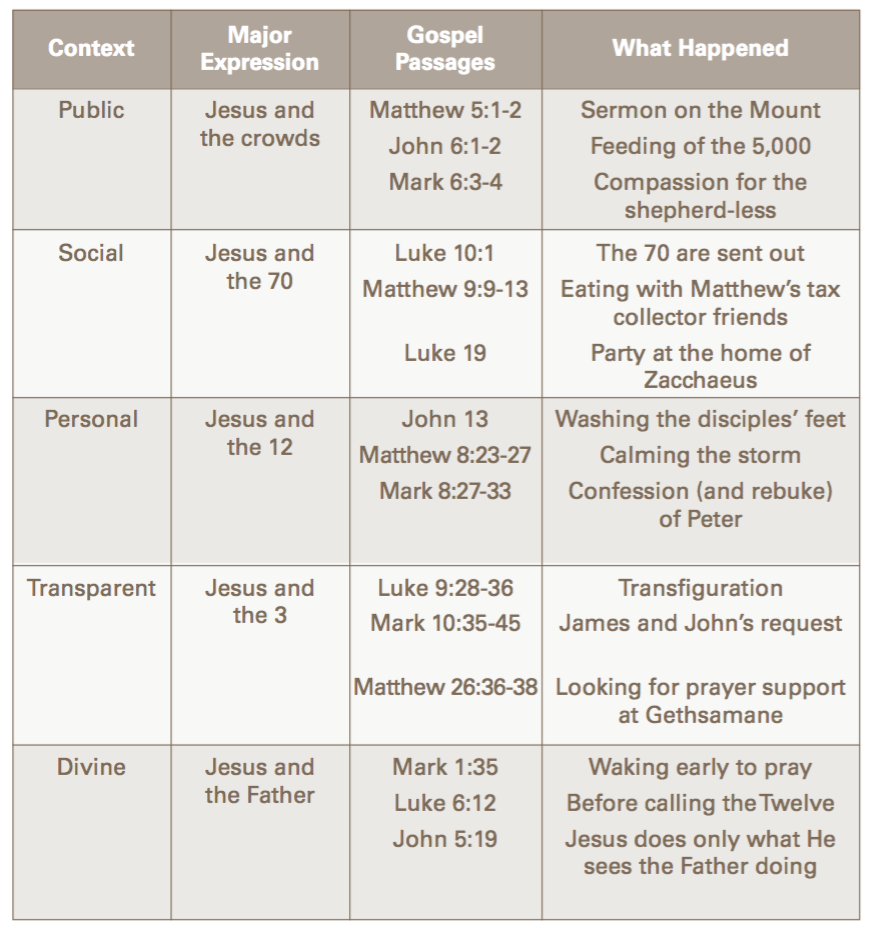
Disciplemaking Leaders: Live Out the Five Relationships of a Disciplemaker
Discipleship is a process that begins after conversion and continues throughout a believer’s life. Discipleship calls for our undivided attention and commitment to follow the commands of our Lord. Discipleship is not an option for any church or believer. Christ mandated it in the Great Commission. To disciple others is to obey our Lord’s command; to do otherwise is to disobey Him.
It becomes easy for every church’s disciple-making mission to get cluttered with lots of things to do. And most church leaders are very good at doing things. As a result, administration of programs replaces actual disciple making practices. As you look ahead to the next year, slow down and refresh your conviction for disciplemaking by looking to the Master himself.
How does a Jesus-centric disciplemaking conviction rescue you from a “program management” culture? Have you resigned to herding people through classes and events? Are you relying too much on better preaching? Or do you have a robust, disciple-making strategy built around life-on-life investment, like Jesus?
THE QUICK SUMMARY – Discipleship That Fits by Bobby Harrington and Alex Absalom
For far too long, the church has tried to make disciples using a one-size-fits-all approach. Some churches advocate 1-on-1 discipling, others try getting everyone into a small group, while still others training through mission trips or service projects. Yet others focus all their efforts on attracting people to a large group gathering to hear biblical teaching and preaching. But does one size really fit everyone?
Based on careful biblical study and years of experience making disciples in the local church, Bobby Harrington and Alex Absalom have identified five key relationships where discipleship happens in our lives. In each relational context we need to understand how discipleship occurs and we need to set appropriate expectations for each context.
Discipleship That Fits shows you the five key ways discipleship occurs. It looks at how Jesus made disciples and how disciples were formed in the early church. Each of the contexts is necessary at different times and in different ways as a person grows toward maturity in Christ.
Filled with examples and stories, the authors show you how to develop discipleship practices in each relational context by sharing how Jesus did it, how the early church practiced it, and how churches are discipling people today.
A SIMPLE SOLUTION
The concept of individualism in American culture has at times approached the level of idolatry, and even influenced the way we think about discipleship. After all, we can learn and grow all by ourselves, right?
The truth is Christians need relationships to grow. We don’t grow in isolation; we develop in the context of relationships with others.
Another truth is that we tend to live isolated lives. While that seems almost laughable in today’s hyper-connected society with some type of screen constantly in our faces, the sad reality is we often don’t know how to relate to people.
So how can we develop relationships that make a difference in our disciplemaking?
In the 1960s, sociologist Edward T. Hall introduced his groundbreaking studies that provided a foundation for developing relationships in the various “spaces” of our lives: public, social, personal, and intimate.
Authors Bobby Harrington and Alex Absalom develop the thought of these four spaces as the context for developing relationships that God uses to help us grow.
God disciples us in many contexts, shaping and molding hearts, minds, and lives – and calling us to imitate his example with those we lead.
The Public Context exists where people gather in the hundreds around a shared outside resource. If the resource is physically present, people will generally be at least 12 feet away from it (think of your distance from the stage if you go see a play or concert). In the environment the focus is on engaging with the outside resource, rather than building relational depth with others who also happen to be there.
The Social Context is the range between twenty and seventy people, where we share snapshots of who we are and thereby seek to build affinity with others. In this context (think of a backyard cookout) three things happen: we build neighborly relations, we start to identify those with whom we’d like to become closer friend, and we reveal elements of our identity and our journey. In terms of proximity, we will be somewhere between 4 and 12 feet apart.
The Personal Context forms in groups of four to twelve, where we feel able to share private information. Think, for instance, of good friends talking over drinks, revealing personal thoughts and feelings about their ongoing lives and relationships. Usually we are 18 inches to 4 feet apart in this context, which is both within comfortable touching distance and close enough to see the other persons as they truly are – warts, wrinkles, and all! Such acceptance and physical closeness are representative of the emotional qualities of a relationship in this context, where we experience a genuine depth of friendship.
The Transparent Context is when you are with just one or two others, making a group of two to four people, your closes to relationships. In this context, characterized by complete openness and candor, nothing is held back. This echoes the biblical idea of being “naked and yet unashamed” – an ideal we live out literally in marriage and metaphorically with our best friends. You are 0 to 18 inches apart in the closes moments of these relationships, noting that at such proximity the other person’s flaws seem to fade away (since your eyes can’t focus on them). This blurring of flaws is a wonderful metaphor for what is going on relationally at these safest depths of human engagement.
The Divine Context represents God’s direct interactions with us, his people, at a one-on-one level. Our focus shifts from cultivating relationship with others to being alone with our Creator and Redeemer as he encounters us in our inner world. We delude ourselves if we believe there can be any barriers in this place; indeed, we come face-to-face with our true selves, as reflected in the loving eyes of our heavenly Father. This communion with God in turn equips us to engage more fruitfully in each of the other four contexts.
Bobby Harrington and Alex Absalom, Discipleship That Fits
A NEXT STEP
Using the table below, conduct a personal study of Jesus and the five different contexts as outlined above.

After completing this study, reflect on what you have learned about the five different types of relationships, how you have grown closer to God because of them, and how you will be better able to disciple others in his name.
What next step is God calling you to take as a result?
Excerpt taken from SUMS Remix 77-2, released October 2017.
This is part of a weekly series posting excerpts from one of the most innovative content sources in the church world: SUMS Remix book excerpts for church leaders.
SUMS Remix takes a practical problem in the church and looks at it with three solutions; each solution is taken from a different book. Additionally, a practical action step is included with each solution.
As a church leader you get to scan relevant books based on practical tools and solutions to real ministry problems, not just by the cover of the book. Each post will have the edition number which shows the year and what number it is in the overall sequence. (SUMS Remix provides 26 issues per year, delivered every other week to your inbox).
> > Subscribe to SUMS Remix <<

Tags: Alex Absalom, Bobby Harrington, Discipleship, Discipleship That Fits












